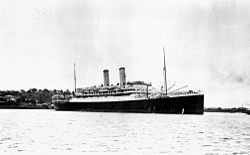Oronsay (ship, 1925)
|
||||||||||||||||||||||||
|
||||||||||||||||||||||||
|
||||||||||||||||||||||||
|
||||||||||||||||||||||||
|
||||||||||||||||||||||||
The Oronsay (I) was a 1925 passenger ship of the British shipping company Orient Steam Navigation Company , which was used in passenger and mail traffic from Great Britain to Australia . On November 9, 1942, the Oronsay was sunk in the Atlantic in service as a troop transport by the Italian submarine Archimede .
The ship
The 20,043 GRT steam turbine ship Oronsay was built at the John Brown & Company shipyard in Clydebank near Glasgow . The 200.83 meter long and 22.86 meter wide ship had two funnels, two masts and two propellers . It was powered by two steam turbines that developed 3811 nominal horsepower and allowed a speed of 18 knots. A total of 1836 passengers could be accommodated in two classes.

The Oronsay was one of five sister ships, all of which weighed around 20,000 GRT and were put into service in the second half of the 1920s. The others were the Orama (II) (1924), the Otranto (II) (1926), the Orford (1928), and the Orontes (II) (1929). The Oronsay was launched on August 14, 1924 and was completed in January 1925. On February 7, 1925, she ran from London on her maiden voyage to Melbourne , Sydney and Brisbane . In 1937 the Australian military contingent traveled to the coronation ceremony of King George VI. on board the Oronsay to England. In December 1938, the ship made a crossing to New Zealand , but was otherwise only used in the Australian service.
War effort
Until the outbreak of war, the Oronsay sailed on the Australian route and, like most of the other ships of the Orient Steam Navigation Company, was occasionally used for cruises . In 1939 it was converted into a troop transport and traveled among other things in special WS convoy trains . On June 17, 1940, the Oronsay was anchored in the mouth of the Loire and took on troops who came on ferries and feeder ships from Saint-Nazaire . With a heavy air raid by the German Luftwaffe was navigating bridge of the ship of bombs hit. Several people died, Captain Norman Savage's leg was broken and the bridge, chart room and radio station were completely destroyed. Under the command of Captain Savage, the Oronsay nevertheless took part in the rescue of the survivors of the Lancastria , which was sunk in the Loire estuary in the same air raid. Savage steered his ship with the help of a pocket compass, a sextant, and a nautical chart .
On October 8, 1940, she was in the Western Approaches , west of Ireland, when she again attacked a German aircraft. In the air attack by a Focke-Wulf Fw 200 of Kampfgeschwader 40 , it got away with damage.
On the morning of October 9, 1942, before sunrise and in heavy rain, the Oronsay was sunk about 500 nautical miles southwest of Freetown in the Atlantic by the Italian submarine Archimede (position 4 ° 29 ′ N , 20 ° 52 ′ W ). The first torpedo fired destroyed the engine room and boiler rooms and brought the ship to a standstill. The Oronsay was on a voyage in the service of the British government from Cape Town to England. On board were 325 crew members, 50 men from the Royal Air Force , eight gunners and 20 rescued seamen. The cargo included 1,200 tons of copper and 3,000 tons of oranges.
A second torpedo was shot down when the lifeboats were launched. Six crew members were killed in the sinking. Most of the survivors, including Captain Savage, were rescued by the destroyer Brilliant and taken to Freetown, where they set off for Glasgow on October 15, 1942, on board Carnarvon Castle . Sixty-three other survivors were picked up by the Vichy warship Dumont D'Urville five days after the sinking and taken to Dakar , where they were taken prisoner . Captain Norman Savage, who had also stood on the bridge of the Orford in 1940 , was named Commander of the Order of the British Empire (CBE) for his work in the rescue of the Lancastria survivors .
Web links
- Short description of the ship in The Ships List (below)
- Technical and historical data in the Clydebuilt Ships Database
- Entry in the wreck database
Individual evidence
- ^ Jürgen Rohwer , Gerhard Hümmelchen : Chronik des Maritime War 1939–1945, October 1940. Retrieved on February 7, 2017 .

